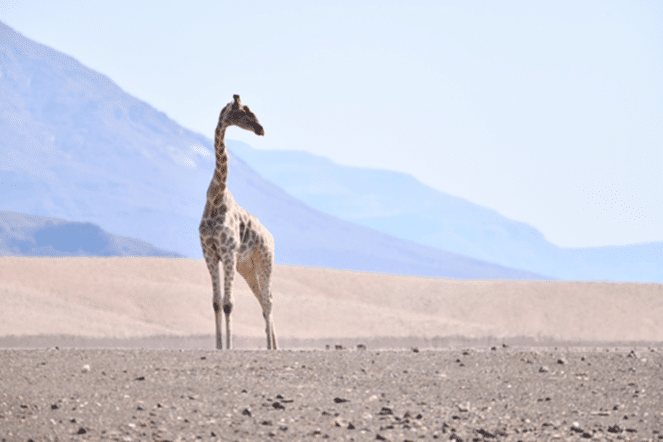North-western Namibia is one of the last remaining ‘wild places’ on the planet. The rugged and unrelenting landscape has an aura that captures the imagination of photographers, geologists and wildlife enthusiasts alike, with unspoiled vistas, baffling rock formations or uniquely adapted species around each turn. This arid environment is awash in dry earthy tones, only broken momentarily by a giraffe awkwardly probing its nostrils with a bright purple tongue.
Conserving Namibia’s desert-dwelling giraffe is one of several conservation initiatives developed by the Giraffe Conservation Foundation (GCF) and the longest-running ecological monitoring programme for giraffes in Africa.
The Northwest Namibia programme is a comprehensive population analysis of Angolan giraffes in the Kunene Region. We estimate the total giraffe population in Namibia at almost 15,000 animals, with 453 of them inhabiting our programme area – the arid to hyper-arid Northwest Namibia, transected by ephemeral (seasonal) rivers that are lifelines for these giraffes and other regional wildlife. Giraffes don’t just survive in this space, they thrive, capitalising on the food and moisture provided by the vegetation that lines these mostly dry riverbeds.

A giraffe peers out from behind the foliage (Image credits: Giraffe Conservation Foundation).
With their striking coat pattern, tall stature and unique morphology, giraffes should be easy to spot. However, their unique coat patterns help them blend almost seamlessly into the mottled shade of their preferred vegetation. Additionally, their spindly legs can easily be mistaken for low branches after a couple of weeks in the desert sun. Mostly, these majestic animals are only given away by a flick of their tail, a slight ear twitch or a ruminating stare protruding from above a Salvadora bush.
The underlying question for this long-term conservation research programme is simple: How do giraffes use their environment and navigate the pressures of such a unique and harsh landscape?
The study area covers approximately 30,000 km2 and comprises communal conservancies, concession areas and the northern stretch of Skeleton Coast National Park. The ephemeral river systems meander through the landscape, providing sustenance in an otherwise barren environment. The stark presence of vegetation supports a host of desert-adapted species from large browsers like elephants and giraffes, to grazing oryx and mountain zebra, the formidable carnivores that have adapted to the unrelenting arid conditions and a scattering of Himba and Herero communities that call this harsh desert landscape home.

The Kunene Region, Namibia, home to the Angolan giraffe (Image credits: Giraffe Conservation Foundation).
While giraffe numbers in the area had dwindled due to the Namibian Independence Struggle and localised poaching, we have seen a steady increase in wildlife over the past 20 years. With the formation of communal conservancies in the region, local communities are demonstrating how wildlife and people can co-exist successfully in self-managed open habitat.
Each month, we survey the three main river systems of the Khumib, Hoarusib and Hoanib Rivers, as well as their many tributaries. We drive along pre-determined routes to spot, record and identify each individual giraffe by taking photos of their left and right side. So far, we have individually identified 453 giraffes, each having a unique coat pattern. During our surveys, we also record information such as herd structure, location, reproductive status and other noteworthy data. Over time, this enables us to understand aspects of their ecology, including the seasonal variations in their movements, how far giraffes wander, why movements differ between individuals in different systems, and their intricate fission-fusion social structure.

A herd of giraffes in the arid Namibian landscape (Image credits: Giraffe Conservation Foundation).
While all this data is critical for gaining a deeper understanding of giraffe ecology, all this time spent observing giraffes has also allowed us to develop a special affinity for some individuals that we observe regularly. One such giraffe is Windy, first identified back in the late 1990s as a subadult. These days, not only is Windy thriving in these harsh desert conditions but she continues to teach us new things: Windy is the oldest giraffe to be confirmed pregnant – at a mature 20 years of age.
In addition to learning more about giraffe ecology and getting to know individual desert-dwelling Angolan giraffes, another satisfying aspect of our programme is the opportunity to connect people with these awkward yet elegant creatures. Sharing our passion for giraffes and their conservation with local people living in the area during our annual game count, co-organised with local conservancy members, is a highlight. So is sharing this very special part of Namibia with international conservation supporters who occasionally join us in the field. For most people, seeing a giraffe confidently traverse wind-swept sand dunes and carefully navigate rocky crests is a great privilege – and a win-win for us – as most visitors leave Northwest Namibia as passionate about giraffe conservation as we are!

A giraffe stretches its long neck to nibble tender leaves near the top of the trees (Image credits: Giraffe Conservation Foundation).
Our findings continue to provide vital insights into the social dynamics of giraffe populations and add to the narrative of their behavioural nuances, feeding strategies, resource usage and other relatively unknown information, fuelling our passion to continue sticking our neck out for giraffes.
Together we #StandTallForGiraffe and can make a difference!

A giraffe against the stark landscape (Image credits: Giraffe Conservation Foundation).


